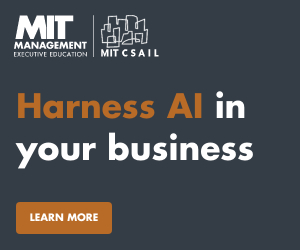Scaling with ModelOps
Putting artificial intelligence (AI) into production can be a frustrating experience for organizations, one often destined for failure. In fact, only 53% of AI projects actually move past POC and into production. Since AI solutions are a determining factor in long-term and continuous success, organizations must meet this issue head-on in order to establish a consistent AI lifecycle.
Ronald van Loon is a Modzy partner, and uses his position as an industry thought leader to better understand the obstacles standing between organizations and AI success, a topic he frequently encounters during his many interactions with companies across industries.
AI and analytics are driving today’s most urgent transformations, yet organizations regularly face insurmountable challenges in AI model deployment, monitoring, and governance for production applications.
Model Operations, or ModelOps, has emerged as a definitive capability in effectively scaling and operationalizing AI and ensuring it can generate value and contribute to the ongoing success of the organization.
With the glaring disconnect between building machine learning (ML) models in a data science lab and putting the models into production, enterprises need an effective process that helps them operationalize and scale their models throughout the organization.
ModelOps holds the potential to drive broad AI adoption and offer data scientists a real-time perspective into model performance while providing meaningful insights to business leaders, positioning it as an enabler for momentum towards the next generation of enterprise AI.
AI Challenges Lead to AI Failures
The most difficult aspects of AI are no longer about competing for data science talent to develop AI models, but determining the best way to take models from the lab to production at scale.
Real world environments are complex and vastly different from lab environments, which often plays a role in the behavior of models in production vs in development and lab environments. So while AI models may be viable in the lab, they don’t perform as planned once they need to be deployed and useful at scale.
This is exacerbated by the fact that it’s simply infeasible to account for every potential situation a model will potentially encounter when put into production across different business functions and units. Also, this process is riddled in both business and technical challenges that only intensify when one model becomes hundreds of models and use cases.
Plus getting AI models into production requires linking them to production data, fusing them with applications, and accounting for infrastructure, a lengthy process that may never come to fruition and lead to model performance issues and reworking.
Another significant challenge is that data scientists may not be skilled in creating scalable software applications, and developers may lack expertise in AI and ML and don’t have an efficient means to build AI models into applications.
A host of other obstacles, including insufficient transparency around these processes that can impact governance and costs, manual handoffs, and frenetic monitoring, further impede the operationalization of AI use cases.
Developing ModelOps Capabilities
ModelOps is the technology, tools, and practices that enable cross-functional AI teams to efficiently deploy, monitor, retrain, and govern AI models in production systems, as defined by Forrester.
ModelOps largely focuses on the AI model life cycle and governance management, and is a rapid, repeatable approach that allows organizations to usher models through the AI model lifecycle to realize quicker deployment and value.
Building ModelOps capabilities helps set companies down a path towards AI deployment success and establish a new standard for AI performance and trustworthiness.
Organizations have some options when it comes to building ModelOps capabilities:
- Leveraging existing ML and analytics solutions: Many data science teams use PAML solutions to build AI models, which have some fundamental ModelOps capabilities that can be quickly leveraged. This might not offer the full spectrum of capabilities and AI model support needed, but it can allow companies to quickly obtain ModelOps capabilities.
- Third-party ModelOps solutions: Specialized ModelOps solutions are arising from vendors who focus on model development, monitoring and governance. These vendors frequently possess expertise in either deploying models throughout numerous environments, managing workflows, tracking KPIs, or security and compliance.
- Developing it in-house: Organizations with mature AI use cases often develop their own solutions, and can develop ModelOps solutions using open source elements from Kubernetes or Data Version Control, for example, along with some open source ML frameworks.
However, it’s frequently more cost and time efficient to turn to vendors who offer ModelOps deployment solutions instead of building and maintaining your own ModelOps platform.
Scaling AI in the Real-World
ModelOps offers a key competitive advantage for business leaders who are tasked with steering their organization forward in AI success, chiefly that it provides insights about model performance and results, eliminating the need for translation into business context from data scientists.
Additionally, ModelOps tools offer data science teams some ground-breaking benefits, including a real-time look into model performance and ensures that overlaps across models, data, and development can be efficiently managed by different teams. These tools can also fit within current tech stacks so data scientists can utilize the model frameworks, languages, and other components they’re already comfortable with.
ModelOps tools can also potentially shorten the average time needed to go from AI model deployment to production from months to just a few hours. This helps eliminate wasted resources, efforts, and time.
Consider the insurance industry, which faces substantial risks in areas such as fraud and is ripe for AI to combat this pervasive issue via fraud detection and mitigation. ModelOps solutions from organizations like Modzy can cut the time needed to deploy AI models to production and requires minimal training, so the time it takes to benefit from AI is significantly accelerated.
To establish a continuously successful AI lifecycle, ModelOps capabilities should encompass:
- AI model deployment: So models can be deployed from anywhere to any environment.
- Tracking model metrics: To account for changing conditions, data drifts, and explainability.
- AI lifecycle governance: To streamline workflows, manage model dependencies, and ensure security and compliance.
To operationalize models, organizations must:
- Start investing in ModelOps capabilities now.
- Facilitate working collaborations across DevOps and ModelOps to ensure ModelOps success.
- Designate a ModelOps leader and equip them with the resources to establish it as a cross-functional capability.
- Incrementally improve and standardize your ModelOps processes and make them broadly accessible to quickly benefit from AI use cases.
- Continuously assess emerging ModelOps offerings for new developments, or prepare a plan for in-house development, depending on which respective solution works best for your unique needs.
ModelOps will help organizations proactively manage costs, and promote governance and transparency for their AI systems. And aside from enabling organizations to realize the benefits of AI faster, specific ModelOps tools can help both companies who are new to AI fast track adoption, as well as AI leaders better manage their AI investments.
Achieving AI Realization
The tantalizing benefits and potential of AI can’t be realized without closing the gap between AI model development and AI model production at scale. Organizations must take advantage of the tools that accelerate AI transparency and management throughout the enterprise, and empower a streamlined, continuous, and responsible approach to model development and deployment.
Check out Modzy for further insights and resources about operationalizing and scaling AI in the enterprise via ModelOps.
By Ronald van Loon










